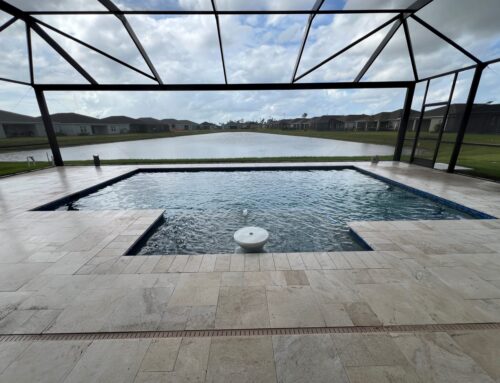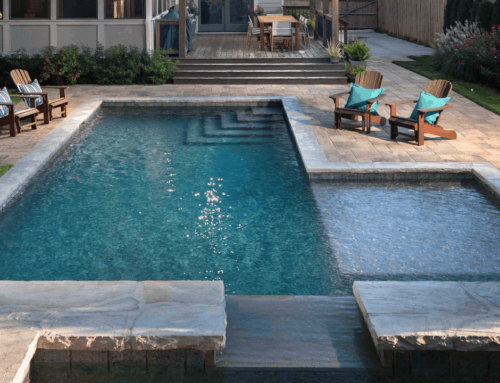Pools face unique risks during extreme weather and with Hurricane Idalia fast approaching many people are wondering what they can do to prepare. With proper preparation, you can minimize damage caused by tropical storms or hurricanes. This guide will help you prepare your pool and patio area as best as possible to minimize damage.
Before The Storm Hits: Prepare Your Outdoor Areas And Pool
Do Not Drain Your Pool
Some may question, “Won’t the pool overflow if we don’t lower the water level?” While there is a possibility, it is no different than if there were a patio or grass in its place. The pool design typically includes proper drainage to mitigate this concern. Retaining water in the pool is crucial to counterbalance the weight and keep it securely in the ground. An empty pool is vulnerable to “floating” or “popping” out due to the “lift” pressure caused by excessive ground water during heavy rains that often accompany storms.
Before the hurricane arrives, make sure to set up a siphon hose by connecting a garden hose from the pool edge to a an area 2-3 feet lower. Keep the hose in position so that you can easily initiate the siphon if the pool starts to overflow.
Switch Off Power To Pool Equipment
To safeguard a pool during a hurricane, it is important to shut off the circuit breakers on the main electrical panel that operate the pools operating equipment. This will prevent the operation of pump motors, lighting, chlorinators, and heaters during the storm’s harshest moments. You can run the pumps and filters during calm weather conditions, but once heavy rain, wind, and lightning ensue, it’s a good idea to switch them off for the duration of the hurricane.
Add A Barrier Of Protection Around Electrical Pool Equipment
After turning off the equipment, use a waterproof plastic membrane to wrap the pump motor, time clock, light transformers, and electric heaters. Secure it tightly to prevent sand and water from getting in. If there is a risk of flooding, it is advisable to disconnect these devices and store them in a dry place. Pay attention to the pool pump, if it becomes submerged it can damage the motor. Take the time to clear the areas around the equipment pad of mulch, leaves, debris, and soil to ensure proper drainage.
Remove All Items From The Pool Area
Loose objects like chairs, tables, toys, and pool cleaning tools can become dangerous projectiles in hurricane-force winds – it’s important to store them inside. While throwing patio furniture into the pool should be a last resort, if you have no other option, gently place these items in the pool to avoid damaging the pools interior finish. However, it is advisable to remove them as soon as possible. To prevent skimmer lids from becoming flying objects, make sure they are securely screwed in place. Additionally, inspect the fence for any loose sections and secure any light posts or signs that may be loose.
Protect Your Screen Enclosure
To prevent potential damage to the frame of a screen structure, consider creating a “vent” to allow wind to flow through. One way to achieve this is by removing screen panels on opposite sides of the enclosure. Simply pull out the vinyl spine that holds the panels in place.
Prevent Contamination With Extra Chlorine
To ensure protection against potential debris and excessive storm water contamination, it is recommended to add a “shock” dose of liquid or granular chlorine as part of proper swimming pool hurricane preparation. For optimal results, lower the pH to approximately 7.2 beforehand and allow the filter to run for several hours after shocking to promote circulation.
Do Not Cover Your Pool
It is a common instinct to immediately cover a pool when preparing for a hurricane. However, it is strongly advised against doing so! Storms can bring strong winds, which can result in falling branches and flying debris that may cause damage to pool covers. It is far easier to remove debris from the pool after the storm, rather than dealing with the costly task of replacing an expensive cover.
Don’t Forget The Yard And Patio Areas
Proper yard and tree maintenance throughout the year is crucial for hurricane preparedness. Ensure the trees surrounding your home are regularly trimmed, paying close attention to weak and low-hanging branches. Removing Spanish moss and keeping limbs under five feet in length will minimize the risk of breakage during strong winds or heavy rain. For branches near utility lines, it’s best to consult a professional or contact your utility company for trimming. Additionally, consider replacing gravel and rock walkways with shredded bark or wood chips, as gravel has been known to damage vinyl house lining. By implementing these measures, you can safeguard your property and enhance hurricane readiness.
Ensure the pool area is free of loose items, including furniture and plants. If feasible, relocate gas and charcoal grills indoors, but DO NOT use them once inside. For larger outdoor objects, securely anchor them to a stable structure using ropes or chains. Never store propane tanks in your home or garage; instead, securely fasten them in an upright position away from your home. While some opt to toss lawn furniture into the pool to prevent them from being carried by strong winds, this may damage the pool’s finish and risk chemical damage to the furniture, particularly if the pool water is super-chlorinated.
What To Do After The Storm
After the storm subsides, take a moment to assess your surroundings before inspecting your pool for any potential damage. Never go near downed power lines and always make sure you contact your local power company to ensure power is functioning properly in your area. If you had submerged any items in the pool, make sure to promptly remove them. It is important to note that the pool water should not be used for drinking or sanitation purposes, as it may still be contaminated or excessively chlorinated. Thoroughly examine the plumbing, pumps, and filters of your pool for any signs of cracks or leaks. Additionally, check the water and chemical levels, and ensure that the valves are set to the circulation position before turning on the pumps. After this, you can restore power to the outlets.
Before restoring power, ensure that all debris is cleared and verify that the electrical system is not damaged. It is advisable to consult a professional before reactivating the system, particularly if there is any suspicion of electrical harm.
Do Not Empty The Pool Post Storm
Following a hurricane, an empty pool is vulnerable to being displaced or dislodged from the ground due to uplift pressure caused by excessive groundwater resulting from heavy rainfall accompanying the storm. If there is a need to drain the pool due to excessive debris, mud, or damage, it is advisable to start by partially draining the water, cleaning the pool, and then refilling it. If a complete drainage becomes necessary, it is recommended that you consult a professional, make sure to wait until the ground is less saturated and any elevated water levels have subsided.
Remove Any Debris From Your Pool
To clear your pool of debris, start by manually removing large objects by hand. For smaller debris, utilize a “leaf rake” or “leaf bagger”. Avoid using the pool’s vacuum system for large debris to prevent plumbing blockages. A Leaf Rake skimmer net can help with removing heavy leaf volume from the surface or floor of the pool.
Before Restarting Your System, Check Your Electrical Equipment
Before turning circuit breakers back on, ensure that waterproof plastic membranes have been removed from electrical devices and that they are completely dry. If these devices have been exposed to water, it is advisable to have them inspected by a licensed professional. Once the necessary precautions have been taken, proceed to turn on the electricity, prime the filter system, and verify that everything is functioning normally.
If your electrical power has not been restored, you can still manually remove debris from the pool using a Leaf Rake or a garden hose-powered pool vacuum. Test the water and add chemicals as necessary, utilizing a pool brush to circulate the water and aid in distributing the chemicals. By skimming and brushing daily, and maintaining proper chlorine and pH levels, you can prevent the pool from deteriorating further until power is restored to the pump.
Run The Filter Equipment
To achieve optimal water clarity, begin by activating the filter pump and running the system for extended periods each day. Once the water has reached the desired level of clarity, adjust the time clock back to a regular daily cycle. When necessary, perform backwashing on the filter to ensure proper flow rates are maintained.
Readjust And Balance Your Pools Water Chemistry
Ensure proper water chemistry in your pool by readjusting the pH, total alkalinity, calcium hardness, and conditioner levels. Monitor these levels diligently over several days, as the addition of soil or debris to the pool can lead to significant changes in water chemistry. Balancing these factors is crucial for effective chlorine sanitation and to prevent staining.
Add Chlorine To Prevent Contamination From Storm Debris
To prevent contamination caused by storm debris and excessive storm water, it is advisable to add a “shock” dose of liquid or granular chlorine to the pool water. If your pool has been flooded and turned the color of soil, you can use a flocculant to sink the heavy solids to the pool floor for vacuuming. It is important to note that heavy soil or debris in the pool is likely to raise the phosphate level. Therefore, it is recommended to use a phosphate remover chemical for flooded pools.
Continue To Monitor Your Pools Overall Operation
After a hurricane, it is crucial to carefully monitor the entire system’s operation for several days. This ensures that everything is functioning correctly and eliminates any potential risks such as electrical hazards, pool leaks, or flooding dangers. Taking these precautions helps ensure the safety and well-being of everyone involved. If you are in doubt, always consult a professional.
Useful Resources
The following resources can help ensure the well-being of yourself, your loved ones, and your home in the face of inclement weather.
The National Hurricane Center of the National Weather Service has helpful tips for ensuring you and your family are prepared for a hurricane’s arrival.
The American Red Cross has great information on disaster alerts and preparation.
Ready.gov has information on hurricane preparation, as well as information on preparing for other natural disasters.
The National Weather Service is one of the best resources to get up-to-date information on hurricanes that are headed your way and those which are still forming.
When a hurricane approaches, there is only so much you can doto safeguard your pool. However, taking proactive measures and being well-prepared beforehand can make a significant impact. Always prioritize your safety above all else—while pools can be repaired, you and your family are irreplaceable!




